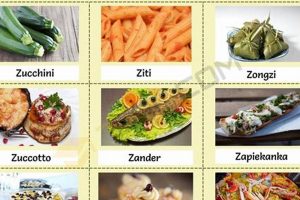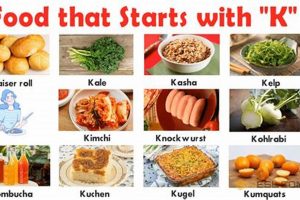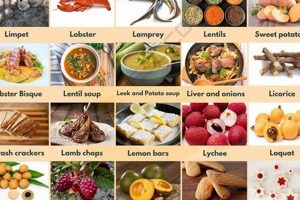Edibles whose names begin with the letter ‘W’ encompass a diverse range of ingredients and dishes. Examples include walnuts, watermelon, waffles, and wheat. These various items represent different food groups, textures, and culinary applications.
The inclusion of ‘W’ foods within a diet can contribute to nutritional diversity. Walnuts, for instance, are a source of healthy fats and protein. Wheat provides carbohydrates and fiber, while watermelon offers hydration and vitamins. Historically, foods starting with ‘W’ have played roles in different cultures’ cuisines, reflecting local agriculture and culinary traditions.
The following sections will delve into specific categories and preparations of culinary items beginning with the letter ‘W’, exploring their origins, nutritional profiles, and usage in contemporary culinary practices. The information presented aims to provide a comprehensive understanding of the breadth and significance of these ingredients.
Culinary Guidance
The following are considerations for optimal selection, preparation, and incorporation of comestibles whose names commence with the letter ‘W’. Adhering to these guidelines can enhance both the culinary experience and nutritional benefits.
Tip 1: Walnut Selection: Choose walnuts that feel heavy for their size and are free from cracks or blemishes. Rancidity is a common concern; purchase from reputable sources and store in airtight containers in a cool, dark place to prolong freshness.
Tip 2: Watermelon Assessment: A ripe watermelon should have a hollow sound when thumped. Look for a creamy yellow spot on the rind, indicating where it rested on the ground while ripening. Avoid watermelons with pale or overly shiny rinds.
Tip 3: Whole Wheat Incorporation: When substituting whole wheat flour for refined flour in baking, be mindful that it absorbs more liquid. Increase the liquid content slightly in recipes to maintain desired texture. Whole wheat breads and pastas provide more fiber than their refined counterparts.
Tip 4: Wok Hei Mastery: When utilizing a wok, preheat it thoroughly before adding oil and ingredients. The concept of “wok hei,” or wok breath, refers to the slight char and smoky flavor imparted by high-heat cooking. Maintain consistent stirring to prevent burning.
Tip 5: Winter Squash Preparation: Acorn, butternut, and other winter squashes can be difficult to cut. Pierce the skin in several places with a fork and microwave for a few minutes to soften the flesh before cutting. Roasting enhances their natural sweetness.
Tip 6: Whipping Cream Stabilization: To stabilize whipped cream and prevent it from weeping, add a small amount of powdered sugar or cornstarch while whipping. Ensure the cream and equipment are thoroughly chilled before beginning.
These recommendations emphasize careful selection, appropriate preparation techniques, and an awareness of the unique characteristics of foods starting with ‘W’. Implementation of these suggestions can lead to improved flavor, texture, and nutritional value.
The subsequent section will explore the role of these items within specific dietary contexts and their contribution to overall well-being.
1. Walnuts
Within the category of “food starts with w,” walnuts stand out as a significant source of healthy fats. This characteristic contributes substantially to their nutritional profile and underscores their importance in a balanced diet. Their fat composition and related health implications warrant detailed examination.
- Omega-3 Fatty Acids
Walnuts contain alpha-linolenic acid (ALA), a plant-based omega-3 fatty acid. ALA is an essential fatty acid, meaning the body cannot produce it and must obtain it from dietary sources. Consumption of ALA is associated with reduced risk of cardiovascular disease and may possess anti-inflammatory properties. This contribution to heart health reinforces the inclusion of walnuts among beneficial “food starts with w.”
- Monounsaturated Fats
In addition to ALA, walnuts provide monounsaturated fats, another type of beneficial fat. These fats can help lower LDL cholesterol levels, often referred to as “bad” cholesterol, and reduce the risk of heart disease. The presence of monounsaturated fats further enhances the nutritional value of walnuts within the spectrum of “food starts with w.”
- Polyunsaturated Fats
Walnuts are a notable source of polyunsaturated fats. These fats are crucial for cell function and overall health. The presence of both omega-3 and omega-6 fatty acids in walnuts contributes to a balanced fatty acid profile, making them a desirable component in the diet and an example of “food starts with w” that promotes well-being.
- Impact on Satiety
The high fat content of walnuts contributes to satiety, the feeling of fullness after eating. This can be beneficial for weight management, as it may help reduce overall calorie intake. By promoting satiety, walnuts can be incorporated into a healthy eating plan as a satisfying and nutritious snack, solidifying their role as a valuable “food starts with w.”
The presence of omega-3 fatty acids, monounsaturated fats, and polyunsaturated fats, coupled with their effect on satiety, positions walnuts as a nutritionally dense food within the “food starts with w” category. Regular consumption, in appropriate portions, can contribute to improved cardiovascular health and overall well-being. The specific fatty acid profile differentiates walnuts from other ‘W’ foods, highlighting their unique contribution to a balanced dietary intake.
2. Watermelon
Within the spectrum of “food starts with w,” watermelon distinguishes itself as a significant source of hydration. This attribute stems from its high water content, making it particularly relevant for maintaining fluid balance, especially in warm climates or during physical activity. The implications of watermelon’s hydrating properties extend to various physiological functions.
- High Water Content
Watermelon comprises approximately 92% water. This substantial water volume directly contributes to overall fluid intake. Consuming watermelon can be an effective strategy for augmenting hydration levels, particularly for individuals who struggle to meet daily fluid recommendations through water alone. The ease of consumption and palatability of watermelon further enhance its value as a hydration source within the “food starts with w” group.
- Electrolyte Contribution
In addition to its high water content, watermelon contains electrolytes such as potassium and magnesium. These electrolytes are crucial for maintaining fluid balance and nerve function. Loss of electrolytes through sweat during physical activity necessitates replenishment, and watermelon provides a natural source of these essential minerals. The combination of water and electrolytes positions watermelon as a beneficial option for rehydration post-exercise, fitting into the “food starts with w” category for athletic recovery.
- Digestive Benefits
The high water content of watermelon aids in digestion by promoting regular bowel movements. Adequate hydration is essential for preventing constipation, and the water in watermelon contributes to maintaining digestive health. This additional benefit strengthens the association between watermelon as a “food starts with w” and overall well-being.
- Nutrient Delivery
The water in watermelon serves as a vehicle for delivering other nutrients, including vitamins and antioxidants. Water-soluble vitamins, such as vitamin C, are more readily absorbed and utilized when consumed with adequate fluid. The hydrating aspect of watermelon, therefore, enhances the bioavailability of other beneficial compounds, reinforcing its role as a nutritionally valuable “food starts with w.”
The multifaceted hydrating properties of watermelon, encompassing its high water content, electrolyte contribution, digestive benefits, and facilitation of nutrient delivery, establish it as a prominent and beneficial item within the “food starts with w” classification. Its role in maintaining fluid balance and supporting various physiological processes underscores its importance in a balanced dietary regimen.
3. Wheat
Wheat, a staple grain in numerous diets globally and a prominent example of “food starts with w,” derives a significant portion of its nutritional value from its fiber content. The quantity and type of fiber present in wheat products directly influence their impact on human health and digestive function. Understanding the nuances of wheat fiber is essential for informed dietary choices.
- Insoluble Fiber: Digestive Regulation
Wheat, particularly whole wheat varieties, is a substantial source of insoluble fiber. This type of fiber does not dissolve in water and adds bulk to the stool, facilitating efficient passage through the digestive tract. Regular consumption of wheat products rich in insoluble fiber can mitigate constipation and promote overall digestive regularity. This benefit reinforces the importance of whole wheat as a “food starts with w” for maintaining gastrointestinal health. Examples include whole wheat bread and bran cereals.
- Soluble Fiber: Cholesterol Management
While wheat primarily contains insoluble fiber, it also provides a smaller amount of soluble fiber. Soluble fiber dissolves in water, forming a gel-like substance that can help lower cholesterol levels. This is achieved by binding to cholesterol in the digestive system and preventing its absorption. The inclusion of wheat in a diet aimed at managing cholesterol levels, therefore, is a practical consideration when evaluating “food starts with w.” Products such as whole wheat pasta contribute to this effect.
- Impact of Processing: Refined vs. Whole Wheat
The degree of processing significantly affects the fiber content of wheat products. Refined wheat, commonly found in white bread and pastries, undergoes milling processes that remove the bran and germ, both of which are rich in fiber. Whole wheat, in contrast, retains these components, resulting in a substantially higher fiber content. Choosing whole wheat over refined wheat is, therefore, a crucial decision when prioritizing fiber intake from “food starts with w.”
- Glycemic Response: Blood Sugar Control
The fiber content of wheat influences its glycemic response, or the rate at which it raises blood sugar levels. Foods high in fiber, such as whole wheat, are digested more slowly, leading to a more gradual increase in blood sugar. This is particularly beneficial for individuals with diabetes or those seeking to manage blood sugar levels. Selecting whole wheat bread over white bread represents a conscious choice to optimize blood sugar control when considering “food starts with w” for dietary inclusion.
The diverse forms and processing levels of wheat reveal varying degrees of fiber content, directly impacting their suitability for specific dietary needs. Prioritizing whole wheat options among the “food starts with w” category maximizes the benefits of fiber, promoting digestive health, cholesterol management, and blood sugar control. Awareness of these distinctions empowers informed choices that leverage the nutritional advantages of wheat fiber.
4. Waffles
The classification of waffles within the “food starts with w” category is intricately linked to their preparation methods. Variations in batter composition, cooking techniques, and ingredient selection directly impact the resulting product’s nutritional value, texture, and overall palatability. Understanding these preparation methods is crucial for discerning the relative merits of different waffle types. For instance, a waffle prepared with refined flour, high levels of sugar, and minimal fat offers a distinct nutritional profile compared to a waffle utilizing whole wheat flour, natural sweeteners, and healthy fats. The cause-and-effect relationship between preparation and nutritional outcome is paramount.
Diverse waffle preparation methods reflect cultural adaptations and culinary preferences. Belgian waffles, characterized by their deep pockets and light, airy texture, typically rely on yeast or whipped egg whites for leavening. American waffles, often denser and cakier, commonly incorporate baking powder or baking soda as a leavening agent. Scandinavian waffles, frequently thinner and crispier, may include cardamom or other spices for flavoring. These regional variations highlight the adaptability of waffles as a “food starts with w” and demonstrate how preparation methods contribute to distinct culinary experiences. Furthermore, the use of varying toppings, from fresh fruit and maple syrup to savory options like fried chicken or eggs, further modifies the waffle’s overall nutritional composition and culinary appeal.
In summary, the preparation methods employed significantly define the characteristics and nutritional implications of waffles within the broader “food starts with w” classification. The choices made regarding batter ingredients, leavening agents, and cooking techniques determine the waffle’s texture, flavor, and nutritional profile. A comprehensive understanding of these factors empowers informed decision-making, enabling consumers to select waffle preparations that align with their dietary needs and culinary preferences. While variations abound, a focus on whole grains, natural sweeteners, and healthy fats can enhance the nutritional value of waffles, transforming them from a simple indulgence into a component of a balanced diet.
5. Winter Squash
Winter squash, a diverse group of vegetables included under the umbrella of “food starts with w” due to cultivars like winter melon, exemplifies the principle of nutrient density. This characteristic indicates a high concentration of vitamins, minerals, and antioxidants relative to its caloric content. The effect of this nutrient density is a significant contribution to overall dietary quality and potential health benefits. The importance of winter squash within the “food starts with w” category lies in its capacity to deliver a substantial micronutrient payload, particularly during seasons when other fresh produce may be less readily available.
Real-life examples of winter squash’s nutrient density are readily apparent in its vitamin A and vitamin C content. Butternut squash, for instance, is an excellent source of vitamin A, vital for vision, immune function, and cell growth. Acorn squash offers significant levels of vitamin C, an antioxidant that supports immune health and protects against cellular damage. Additionally, winter squash provides dietary fiber, potassium, and various B vitamins. Practical applications of this understanding include strategic menu planning, ensuring adequate intake of essential nutrients by incorporating winter squash into meals, particularly in autumn and winter. Roasting, steaming, and pureeing are common preparation methods that preserve the nutritional value of winter squash.
In conclusion, winter squash represents a prime example of nutrient density within the “food starts with w” classification. Its concentrated levels of vitamins, minerals, and fiber make it a valuable addition to a balanced diet. Challenges may involve consumer familiarity with diverse winter squash varieties and appropriate preparation techniques. However, promoting education on the nutritional benefits and culinary versatility of winter squash can further enhance its utilization, contributing to improved dietary outcomes and overall well-being. The broader theme underscores the significance of selecting nutrient-dense foods to optimize health and prevent nutrient deficiencies, and “winter squash” is one such option.
Frequently Asked Questions
The following addresses common inquiries and clarifies misconceptions regarding foods whose names commence with the letter ‘W’. This section provides factual information to promote a better understanding of their nutritional value and culinary applications.
Question 1: Are all foods starting with ‘W’ inherently healthy?
No. The healthfulness of a food starting with ‘W’, similar to any food group, depends on its nutrient composition and preparation method. While walnuts offer beneficial fats and fiber, waffles prepared with refined flour and excessive sugar may provide limited nutritional value. Judicious selection is paramount.
Question 2: What is the best way to store walnuts to preserve their freshness?
Walnuts are prone to rancidity due to their high fat content. Optimal storage involves placing them in an airtight container and refrigerating or freezing them. This minimizes exposure to oxygen, light, and heat, thereby extending their shelf life and preserving flavor.
Question 3: Is watermelon a good source of nutrients besides water?
Yes. While watermelon is primarily water, it also provides vitamins A and C, as well as lycopene, an antioxidant associated with reduced risk of certain diseases. Its electrolyte content, including potassium and magnesium, further contributes to its nutritional profile.
Question 4: How does the fiber content of whole wheat compare to that of refined wheat?
Whole wheat contains significantly more fiber than refined wheat. The milling process for refined wheat removes the bran and germ, the fiber-rich components of the grain. Choosing whole wheat products over refined wheat options is a simple strategy to increase fiber intake.
Question 5: Are there healthy ways to prepare waffles?
Yes. Preparing waffles using whole wheat flour, incorporating fruits or vegetables into the batter, and using natural sweeteners can significantly enhance their nutritional value. Limiting added sugars and unhealthy fats is also crucial.
Question 6: What are some common varieties of winter squash?
Common varieties of winter squash include butternut squash, acorn squash, spaghetti squash, and kabocha squash. Each variety possesses a unique flavor profile and nutritional composition, offering diverse culinary applications.
These clarifications underscore the importance of informed choices when incorporating foods starting with ‘W’ into a balanced diet. Consideration of nutrient content, preparation methods, and storage techniques is essential for maximizing their potential benefits.
The subsequent section will delve into practical applications of these insights, providing actionable recommendations for incorporating ‘W’ foods into daily meal plans.
Conclusion
The preceding discussion has elucidated the diverse characteristics of edibles whose nomenclature commences with the letter ‘W’. From the nutritional density of walnuts and winter squash to the hydrating properties of watermelon and the fiber content of wheat, each item presents unique attributes impacting dietary quality. The importance of preparation methods and selection criteria has been emphasized to optimize the nutritional benefits derived from these comestibles.
The deliberate incorporation of informed choices within the ‘food starts with w’ category holds potential for enhanced dietary outcomes. Continued research into the specific health effects of these items and dissemination of accurate information will further empower individuals to make informed decisions. A focus on whole, unprocessed options and mindful preparation techniques remains paramount for maximizing the contribution of ‘W’ foods to overall well-being.







